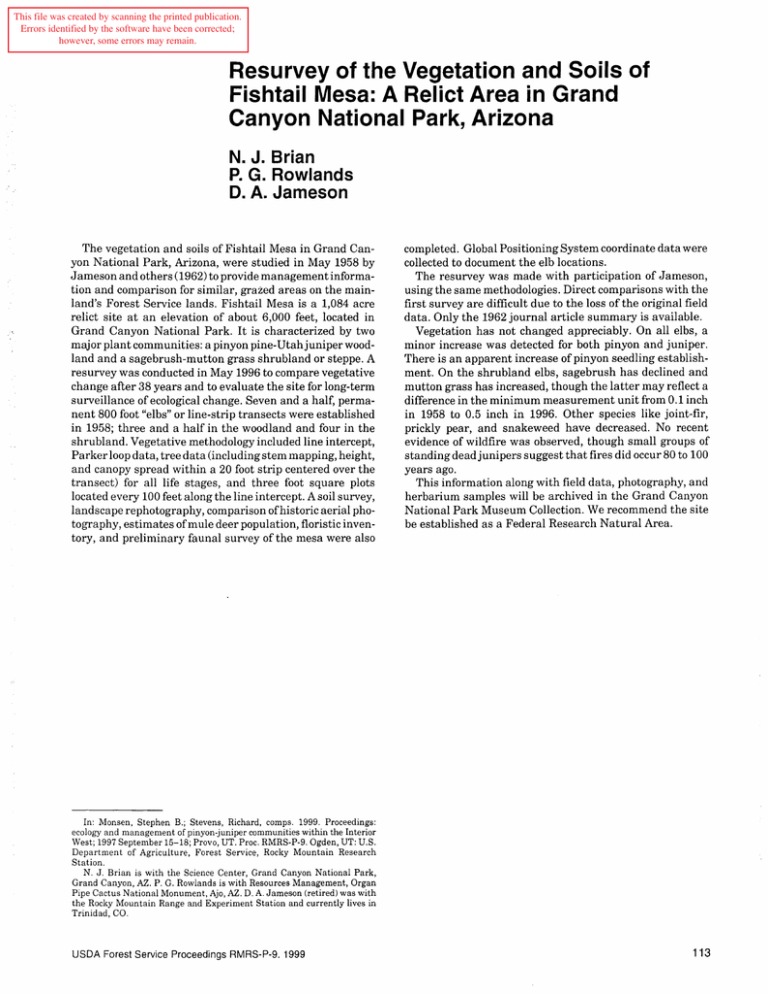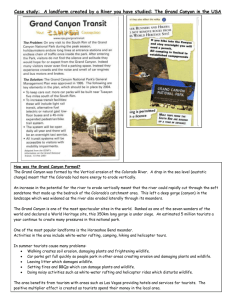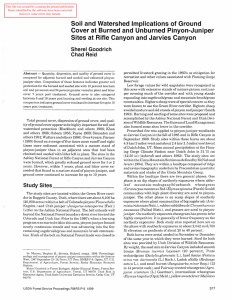Document 11871922
advertisement

This file was created by scanning the printed publication. Errors identified by the software have been corrected; however, some errors may remain. Resurvey of the Vegetation and Soils of Fishtail Mesa: A Relict Area in Grand Canyon National Park, Arizona N. J. Brian P. G. Rowlands D. A. Jameson The vegetation and soils of Fishtail Mesa in Grand Canyon National Park, Arizona, were studied in May 1958 by Jameson and others (1962) to provide management information and comparison for similar, grazed areas on the mainland's Forest Service lands. Fishtail Mesa is a 1,084 acre relict site at an elevation of about 6,000 feet, located in Grand Canyon National Park. It is characterized by two major plant communities: a pinyon pine-Utahjuniper woodland and a sagebrush-mutton grass shrubland or steppe. A resurvey was conducted in May 1996 to compare vegetative change after 38 years and to evaluate the site for long-term surveillance of ecological change. Seven and a half, permanent 800 foot "elbs" or line-strip transects were established in 1958; three and a half in the woodland and four in the shrubland. Vegetative methodology included line intercept, Parker loop data, tree data (including stem mapping, height, and canopy spread within a 20 foot strip centered over the transect) for all life stages, and three foot square plots located every 100 feet along the line intercept. A soil survey, landscape rephotography, comparison of historic aerial photography, estimates of mule deer population, floristic inventory, and preliminary faunal survey of the mesa were also completed. Global Positioning System coordinate data were collected to document the elb locations. The resurvey was made with participation of Jameson, using the same methodologies. Direct comparisons with the first survey are difficult due to the loss of the original field data. Only the 1962 journal article summary is available. Vegetation has not changed appreciably. On all elbs, a minor increase was detected for both pinyon and juniper. There is an apparent increase of pinyon seedling establishment. On the shrubland elbs, sagebrush has declined and mutton grass has increased, though the latter may reflect a difference in the minimum measurement unit from 0.1 inch in 1958 to 0.5 inch in 1996. Other species like joint-fir, prickly pear, and snakeweed have decreased. No recent evidence of wildfire was observed, though small groups of standing dead junipers suggest that fires did occur 80 to 100 years ago. This information along with field data, photography, and herbarium samples will be archived in the Grand Canyon National Park Museum Collection. We recommend the site be established as a Federal Research Natural Area. In: Monsen, Stephen B.; Stevens, Richard, comps. 1999. Proceedings: ecology and management of pinyon-juniper communities within the Interior West; 1997 September 15-18; Provo, UT. Proc. RMRS-P-9. Ogden, UT: U.S. Department of Agriculture, Forest Service, Rocky Mountain Research Station. N. J. Brian is with the Science Center, Grand Canyon National Park, Grand Canyon, AZ. P. G. Rowlands is with Resources Management, Organ Pipe Cactus National Monument, Ajo, AZ. D. A. Jameson (retired) was with the Rocky Mountain Range and Experiment Station and currently lives in Trinidad, CO. USDA Forest Service Proceedings RMRS-P-9. 1999 113




